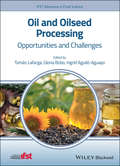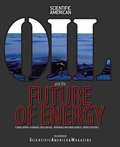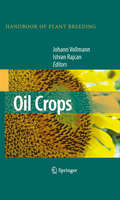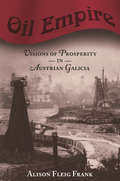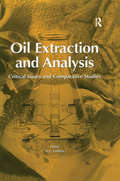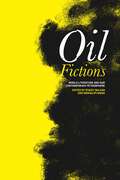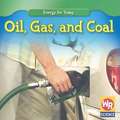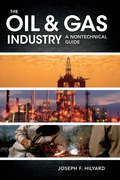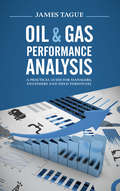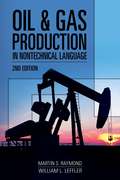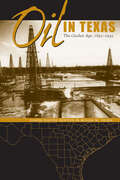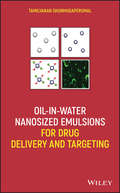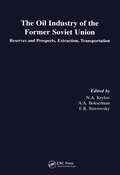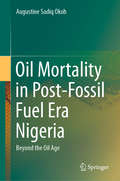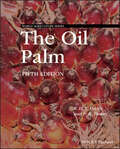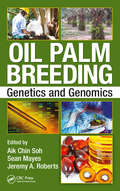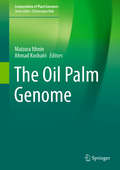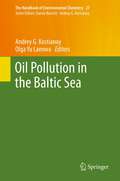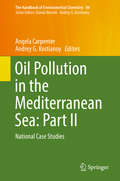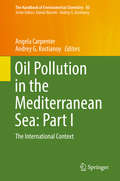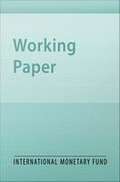- Table View
- List View
Oil and Oilseed Processing: Opportunities and Challenges (IFST Advances in Food Science)
by Tomás Lafarga Gloria Bobo Ingrid Aguiló-AguayoThe latest information available on oil and oilseed processing Oil and Oilseed Processing offers a comprehensive text that explores both the conventional and novel “green” extraction methods used to extract oils from seeds. The authors—noted experts on the topic—examine the positive aspects of operations in processing oil and oilseeds and present new processing concepts, principles, effects on quality, as well as the stability characteristics, limitations, and challenges. Due to the economic implications associated with the overproduction of seed oils, the book includes pertinent information on vegetable and animal-derived oils for industrial applications. The authors also explore recent applications and future perspectives for vegetable and animal oils use in the food and non-food industry. Safety concerns regarding oil and oilseed processing and waste valorisation are also covered in-depth. This important guide: Explores the traditional and new extraction methods used to extract oils from seeds Contains the most up-to-date insight into oil and oilseed processing Focuses on the areas of oil processing, safety, quality, and nutritional evaluation Written for food scientists and professional food technologists, Oil and Oilseed Processing is the only book on the market that contains the most recent information on all aspects of oil and oilseed processing.
Oil and the Future of Energy
by Scientific AmericanOil and the Future of Energy brings together the most important and accessible science writing on a topic of intense public interest and concern. In addition to oil, writers cover carbon and climate change, hydrogen, nuclear power, conservation, renewable resources, transitional strategies, and visionaries in the field today. With their impeccable reputation for top science reporting, the editors of Scientific American present influential research and thinking from the most important scientists working with these burning global issues today. This one volume is an unparalleled resource for businesspeople, investors, and individuals who care about the planet.
Oil Crops
by Johann Vollmann Istvan RajcanThe volume on oil crop breeding is the third volume in the series, Handbook of Plant Breeding after the initial volumes on Vegetables and Cereals. Like the other volumes in the series, the volume will present information on the latest in applied plant breeding using the current advances in the field. The book consists of a total number of 19 chapters, with 17 being devoted to individual crops and two chapters dealing with general aspects of oil crop breeding. Outstanding scientists for each crop species are proposed as senior authors, who may invite co-authors to contribute part of a chapter. In order to increase the overall acceptance of the volume, authors from different research groups/countries have been asked to collaborate (if possible) on one and the same chapter in particular crops. The book is comprised primarily of specific issues and techniques pertaining to individual crops. It provides an update of the new oilseed crop development covering mainly Limnanthes ssp. and Cuphea ssp., which represent newly domesticated oil crop species with unique crop or oil characteristics. The last two chapters in the book are designed as introductory or review chapters; they highlight topics of general interest in oil crop breeding such as domestication/genetic diversity, oil crop breeding targets, oil crop and human health issues, selection strategies with biotechnologies and analytical techniques as well as genetic engineering of fatty acid profiles. This book is of interest to researchers in both academic and industrial setting as well as students and teachers of plant breeding.
Oil, Democracy, and Development in Africa
by John R. HeilbrunnThis book focuses on the history, key industry and policy actors, and political economic outcomes in oil-producing African states, filling a gap in the literature on resource-abundant countries by providing an optimistic assessment of circumstances in contemporary Africa. John R. Heilbrunn's historical analysis investigates the origins of how different policy makers responded to inflows of oil windfalls. In doing so, Heilbrunn illustrates how outcomes vary as a consequence of the goals of particular actors that are distinct from the activities in their country's oil sector. This contribution calls for a reassessment of how we consider the impact of oil on developing economies.
Oil, Dollars, Debt, and Crises
by Mahmoud A. El-Gamal Amy Myers JaffeOil, Dollars, Debt, and Crises studies the causes of the current oil and global financial crisis and shows how America's and the world's growing dependence on oil has created a repeating pattern of banking, currency, and energy-price crises. Unlike other books on the current financial crisis, which have focused on U. S. indebtedness and American trade and economic policy, Oil, Dollars, Debt, and Crises shows the reader a more complex picture in which transfers of wealth to and from the Middle East result in a perfect storm of global asset and financial market bubbles, increased unrest, terrorism and geopolitical conflicts, and eventually rising costs for energy. Only by addressing long-term energy policy challenges in the West, economic development challenges in the Middle East, and the investment horizons of financial market players can policy makers ameliorate the forces that have been causing repeating global economic crises.
Oil Empire: Visions of Prosperity in Austrian Galicia
by Alison Fleig FrankThis study describes the human institutions, traditions, and preoccupations that helped shape the oil industry in the Austrian Empire and contributed as much to its fate as the geological features, the oil that that industry began to exploit a mere century and a half ago.
Oil Extraction and Analysis: Critical Issues and Competitive Studies
by D. L. LuthriaThis book contains papers from the symposium "Critical Issues, Current and Emerging Technologies for Determination of Crude Fat Content in Food, Feed and Seeds," held in 2003 at the AOCS Annual Meeting in Kansas City, Missouri. The topics covered give a broad perspective of the challenges and issues of the value-added enhanced products. This book w
Oil Fictions: World Literature and Our Contemporary Petrosphere (AnthropoScene)
by Stacey Balkan and Swaralipi NandiOil, like other fossil fuels, permeates every aspect of human existence. Yet it has been largely ignored by cultural critics, especially in the context of the Global South. Seeking to make visible not only the pervasiveness of oil in society and culture but also its power, Oil Fictions stages a critical intervention that aligns with the broader goals of the energy humanities.Exploring literature and film about petroleum as a genre of world literature, Oil Fictions focuses on the ubiquity of oil as well as the cultural response to petroleum in postcolonial states. The chapters engage with African, South American, South Asian, Iranian, and transnational petrofictions and cover topics such as the relationship of colonialism to the fossil fuel economy, issues of gender in the Thermocene epoch, and discussions of migration, precarious labor, and the petro-diaspora. This unique exploration includes testimonies of the oil encounter—through memoirs, journals, and interviews—from a diverse geopolitical grid, ranging from the Permian Basin to the Persian Gulf.By engaging with non-Western literary responses to petroleum in a concentrated, sustained way, this pathbreaking book illuminates the transnational dimensions of the discourse on oil. It will appeal to scholars and students working in literature and science studies, energy humanities, ecocriticism, petrocriticism, environmental humanities, and Anthropocene studies.In addition to the editors, the contributors to this volume include Henry Obi Ajumeze, Rebecca Babcock, Ashley Dawson, Sharae Deckard, Scott DeVries, Kristen Figgins, Amitav Ghosh, Corbin Hiday, Helen Kapstein, Micheal Angelo Rumore, Simon Ryle, Sheena Stief, Imre Szeman, Maya Vinai, and Wendy W. Walters.
Oil, Gas, and Coal
by Tea BenduhnOur lives would be very different without oil, gas, and coal. These fossil fuels help heat our homes, turn on our lights, and power our cars and trucks. But they also damage our environment-and they won't last forever. Learn how we use these energy sources today and find out how we might use them with cleaner sources of energy in the future.
The Oil & Gas Industry: A Nontechnical Guide
by Joseph HilyardJoseph Hilyard's timely new book provides a broad perspective on the oil and gas industry, with primary attention to the United States. It takes the reader on a tour of the operations used to find and evaluate resources, and then to produce, store and deliver oil and gas. The book's main focus is primarily on the equipment and processes used in exploring new resources; evaluating promising formations; drilling wells; managing oil and gas production; converting oil and gas into products; and transporting oil and gas. Separate chapters address the evolution and current structure of the petroleum industry; oil and gas trading; and challenges likely to face the oil and gas industry in coming years. Three appendices define key industry terminology; suggest further reading on selected topics; and identify organizations that can provide more information.
Oil & Gas Performance Analysis: A Practical Guide for Managers, Engineers and Field Personnel
by James TaguePerformance analysis is generally conducted in the higher echelons of an oil and gas company, and thus its value in creating actionable information at the field level is generally lost. This book seeks to bridge this gap by introducing the basic concepts of oil and gas performance analysis.
Oil & Gas Production in Nontechnical Language
by Martin S. Raymond William L. LefflerThis updated second edition of Oil & Gas Production in Nontechnical Language is an excellent introduction for anyone from petroleum engineers and geologists new to their careers to financial, marketing, legal, and other professionals and their staffs interested in the industry. E&P service company personnel will find it particularly beneficial in understanding the roles played by their clients. Not only does it cover production fundamentals, but it backs up to give the necessary upstream background—geology, origins of oil and gas, and ownership and land rights—as well as surface operations and even production company strategy development.
Oil in Texas: The Gusher Age, 1895–1945 (Clifton and Shirley Caldwell Texas Heritage Series)
by Diana Davids Hinton Roger M. Olien"Comprehensive in its coverage, clearly organized and written, and thoroughly researched, this book fills a significant hole in the historical literature on Texas oil. "--Joe Pratt, Cullen Professor of History and Business, University of HoustonAs the twentieth century began, oil in Texas was easy to find, but the quantities were too small to attract industrial capital and production. Then, on January 10, 1901, the Spindletop gusher blew in. Over the next fifty years, oil transformed Texas, creating a booming economy that built cities, attracted out-of-state workers and companies, funded schools and universities, and generated wealth that raised the overall standard of living--even for blue-collar workers. No other twentieth-century development had a more profound effect upon the state. In this book, Roger M. Olien and Diana Davids Olien chronicle the explosive growth of the Texas oil industry from the first commercial production at Corsicana in the 1890s through the vital role of Texas oil in World War II. Using both archival records and oral histories, they follow the wildcatters and the gushers as the oil industry spread into almost every region of the state. The authors trace the development of many branches of the petroleum industry--pipelines, refining, petrochemicals, and natural gas. They also explore how overproduction and volatile prices led to increasing regulation and gave broad regulatory powers to the Texas Railroad Commission.
Oil in the Environment
by John A. WiensWhat light does nearly 25 years of scientific study of the Exxon Valdez oil spill shed on the fate and effects of a spill? How can the results help in assessing future spills? How can ecological risks be assessed and quantified? In this, the first book on the effects of Exxon Valdez in 15 years, scientists directly involved in studying the spill provide a comprehensive perspective on, and synthesis of, scientific information on long-term spill effects. The coverage is multidisciplinary, with chapters discussing a range of issues including effects on biota, successes and failures of post-spill studies and techniques, and areas of continued disagreement. An even-handed and critical examination of more than two decades of scientific study, this is an invaluable guide for studying future oil spills and, more broadly, for unraveling the consequences of any large environmental disruption. For access to a full bibliography of related publications, follow the Resources link at www. cambridge. org/9781107027176.
Oil-in-Water Nanosized Emulsions for Drug Delivery and Targeting
by Tamilvanan ShunmugaperumalThis book combines emulsion knowledge into a single, comprehensive volume, ideal for professionals and students involved in the areas of pharmaceutical science who are looking to learn about this emergent research concept. Compiles the step-by-step investigations made concerning the potential of nanosized emulsions on both drug delivery and drug targeting areas by different group of scientists in various laboratories across the world Inverts the common nano-emulsions coverage trend of focusing on focused on the particulate system itself, instead exploring the way to turn nanosized emulsions as biomedical tool, as well as, treating the in vitro and in vivo aspects after administration Provides an overview of the current state-of-the art regarding the development of tocol emulsions, emulsion adjuvants in immunization research, oxygen-carrying emulsions (called as fluorocarbon emulsion) and emulsions for delivering drugs to nasal and topical (ocular and transdermal) routes
Oil Industry of the Former Soviet Union - Reserves, Extraction and Transportation: Reserves, Extraction and Transportation
by N Krylov A. Boksernan E StavrovskyThe Russian Federation is a leading oil producer and has a major oil supply system. This book describes the current Russian situation and prospects for the future development of its industry. Accurate data on the Russian system of oil pipelines are published here in English for the first time and will be useful to those interested or involved in the oil business. The book provides information on technologies used, including their technical and economic characteristics and current research. Part I discusses oil reserves and current resource base, prospects for their development, potential oil reserves, and those already explored. Part II discusses conditions under which oil is produced and describes features particular to Russian oil production, associated problems and technologies, including their engineering and economic aspects. Part III highlights the background, current state, and operational problems of the oil transportation system of the Federation and other countries of the former Soviet Union - one of the world's largest energy systems. Also reviewed are the technical state and operational reliability of the main pipeline network, including a general description of the pipeline system, design and construction of oil pipelines, repair and maintenance, and economic and control problems.
Oil Mortality in Post-Fossil Fuel Era Nigeria: Beyond the Oil Age
by Augustine Sadiq OkohThis book provides an insight into the complexities of weaning Nigeria from its fossil fuels addiction while growing the economy on low carbon trajectory. Nigeria faces a carbon catch 22 with the proliferation of renewable energy alternatives and scale-up of electric vehicles. The dilemma Nigeria is confronted with is to grow its fossil-led economy or face the challenge of its fossil infrastructure becoming stranded assets. It is a roadmap for plotting an environmentally benign path out of the country’s economic, social and environmental crises. This book is, therefore, a valuable resource for students, Civil Society Organizations, policymakers, academics and climate change adaptation practitioners who are interested in finding an environmentally sensitive path out of Nigeria’s economic cul-de-sac fostered by the decarbonization of the global energy economy. Findings of this study will trigger a national conversation on the looming exit from fossil fuels. In doing so, accelerate the integration of renewable energy into the Nigerian national development plan while building a carbon neutral society. Lessons learnt from the handling of Nigeria’s precarious circumstance will be of immense benefit to other oil prospecting, oil producing and non-producing nations who are interested in finding an equitable way of pursuing two inversely related goals of meeting their decarbonization commitments while simultaneously growing their economies in the post-Paris era.
Oil on the Brain: Adventures from the Pump to the Pipeline
by Lisa MargonelliDiscusses the international problems involved in oil distribution.
The Oil Palm (World Agriculture Series #1)
by R. H. Corley P. B. TinkerThe oil palm is the world's most valuable oil crop. Its production has increased over the decades, reaching 56 million tons in 2013, and it gives the highest yields per hectare of all oil crops. Remarkably, oil palm has remained profitable through periods of low prices. Demand for palm oil is also expanding, with the edible demand now complemented by added demand from biodiesel producers. The Oil Palm is the definitive reference work on this important crop. This fifth edition features new topics - including the conversion of palm oil to biodiesel, and discussions about the impacts of palm oil production on the environment and effects of climate change – alongside comprehensively revised chapters, with updated references throughout. The Oil Palm, Fifth Edition will be useful to researchers, plantation and mill managers who wish to understand the science underlying recommended practices. It is an indispensable reference for agriculture students and all those working in the oil palm industry worldwide.
Oil Palm Breeding: Genetics and Genomics
by Aik Chin Soh, Sean Mayes, and Jeremy RobertsThe oil palm is a remarkable crop, producing around 40% of the world’s vegetable oil from around 6% of the land devoted to oil crops. Conventional breeding has clearly been the major focus of genetic improvement in this crop. A mix of improved agronomy and management, coupled with breeding selection have quadrupled the oil yield of the crop since breeding began in earnest in the 1920s. However, as for all perennial crops with long breeding cycles, oil palm faces immense challenges in the coming years with increased pressure from population growth, climate change and the need to develop environmentally sustainable oil palm plantations. In Oil Palm: Breeding, Genetics and Genomics, world leading organizations and individuals who have been at the forefront of developments in this crop, provide their insights and experiences of oil palm research, while examining the different challenges that face the future of the oil palm. The editors have all been involved in research and breeding of oil palm for many years and use their knowledge of the crop and their disciplinary expertise to provide context and to introduce the different research topics covered.
The Oil Palm Genome (Compendium of Plant Genomes)
by Maizura Ithnin Ahmad KushairiThis book compiles the fundamental advances resulting from of oil-palm genome and transcriptome sequencing, and describes the challenges faced and strategies applied in sequencing, assembling and annotating oil palm genome sequences. The availability of genome and transcriptome data has made the mining of a high number of new molecular markers useful for genetic diversity as well as marker-trait association studies and the book presents high-throughput genotyping platforms, which allow the detection of QTL regions associated with interesting oil palm traits such as oil unsaturation and yield components using classical genetic and association mapping approaches. Lastly, it also presents the discovery of major genes governing economically important traits of the oil palm.Covering the history of oil palm expansion, classical and molecular cytogenetics, improvements based on wild and advanced genetic materials, and the science of oil palm breeding, the book is a valuable resource for scientists involved in plant genetic research.
Oil Pollution in the Baltic Sea
by Andrey G. Kostianoy Olga Yu LavrovaThis thorough review is based on observational satellite, airborne and in-situ data, scientific literature and technical reports, as well as the substantial experience of the authors, who hail from several Baltic Sea countries. They pay special attention to national practices, HELCOM and EMSA CleanSeaNet activities in oil pollution monitoring, and show different applications of the Seatrack Web model for oil spill drift prediction and the identification of illegal polluters, as well as for environmental risk assessment. Furthermore, some of the results on satellite monitoring of the Nord Stream gas pipeline construction in the Gulf of Finland are presented. This volume addresses the needs of specialists working in different fields of marine, environmental, and remote sensing sciences. It is a useful handbook on oil pollution for international and governmental agencies, as well as for policy makers who plan and manage oil and gas projects, the construction of ports and terminals, shipping, fishery, recreation, and tourist activities in the Baltic Sea. It also offers graduate and undergraduate students in marine and environmental sciences a valuable resource and reference work on the subject.
Oil Pollution in the Mediterranean Sea: National Case Studies (The Handbook of Environmental Chemistry #84)
by Angela Carpenter Andrey G. KostianoyThis volume reviews the oil inputs to the Mediterranean Sea from sources such as shipping, offshore oil installations, and oil refineries, presented in a number of national case studies. A regional overview is also presented for the Adriatic Sea. Topics include mapping of oil slicks in the Adriatic, oil exploration and exploitation activities in the waters of the Levantine Basin (Eastern Mediterranean), the oil pollution preparedness and response activities of individual Mediterranean states, bilateral and regional cooperation among the various states, and the risk of pollution from shipping in sensitive sea areas, for example. Together with the companion volume Oil Pollution in the Mediterranean Sea: Part I - The International Context, it addresses both national and international measures in the region, making it of relevance to the agencies and government bodies tasked with remediating or preventing oil pollution, as well as policymakers and practitioners in the fields of shipping, ports and terminals, oil extraction and marine management. It provides researchers with essential reference material on tools and techniques for monitoring oil pollution, and constitutes a valuable resource for undergraduate and post-graduate students in the field of marine oil pollution.
Oil Pollution in the Mediterranean Sea: The International Context (The Handbook of Environmental Chemistry #83)
by Angela Carpenter Andrey G. KostianoyThis volume offers a review of oil inputs to the Mediterranean Sea from sources such as shipping, and offshore exploration and exploitation activities. It discusses international measures to prepare for, respond to, and prevent oil pollution incidents, as well as the international legal framework and agencies with a role in pollution prevention and responses. It includes chapters on modeling the fate of oil pollution, oil spill response, and oil spill beaching probability, and presents data from a range of sources, including historic data on shipping accidents and oil exploration and exploitation activities, satellite and remote sensing data, and numerical modelling data, to provide an overview of oil pollution over several years. Topics covered include modelling of oil slicks in the eastern and western Mediterranean basins, oil exploration and exploitation activities in the waters of the Levantine Basin (Eastern Mediterranean), and signatures to and ratification of the Barcelona Convention and its Protocols, for example. Together with the companion volume Oil Pollution in the Mediterranean Sea: Part II - National Case Studies, it addresses both national and international measures in the region, making it of relevance to the agencies and government bodies tasked with remediating or preventing oil pollution, as well as policymakers and practitioners in the fields of shipping, ports and terminals, oil extraction and marine management. It provides researchers with essential reference material on tools and techniques for monitoring oil pollution, and serves as a valuable resource for undergraduate and postgraduate students in the field of marine oil pollution.
Oil Prices and Bank Profitability: Evidence from Major Oil-Exporting Countries in the Middle East and North Africa
by Tigran Poghosyan Heiko HesseA report from the International Monetary Fund.
